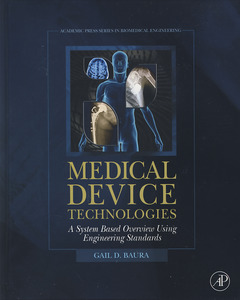Description
Medical Device Technologies
A Systems Based Overview Using Engineering Standards
Author: Baura Gail
Language: English
Subjects for Medical Device Technologies:
Publication date: 10-2018
528 p. · 19x23.3 cm · Paperback
Replaced by new edition: Access to the new edition.
Publication date: 11-2011
528 p. · 19x23.3 cm · Hardback
Replaced by new edition: Access to the new edition.
Description
/li>Contents
/li>Readership
/li>Biography
/li>Comment
/li>
Medical Device Technologies introduces undergraduate engineering students to commonly manufactured medical devices. It is the first textbook that discusses both electrical and mechanical medical devices.
The first 20 chapters are medical device technology chapters; the remaining eight chapters focus on medical device laboratory experiments. Each medical device chapter begins with an exposition of appropriate physiology, mathematical modeling or biocompatibility issues, and clinical need. A device system description and system diagram provide details on technology function and administration of diagnosis and/or therapy. The systems approach lets students quickly identify the relationships between devices.
Device key features are based on five applicable consensus standard requirements from organizations such as ISO and the Association for the Advancement of Medical Instrumentation (AAMI).
Throughout her career, Dr. Baura has championed engineering curriculum excellence. She has written four engineering textbooks, three of which are medical device textbooks. She is an ABET Engineering Accreditation Commissioner. In her new position as Director of Engineering Science at Loyola, she is constructing a general engineering curriculum that incorporates substantial industry input and prepares new engineering graduates for positions in the medical device, semiconductor, and wastewater treatment industries.
- The medical devices discussed are Nobel Prize or Lasker Clinical Prize winners, vital signs devices, and devices in high industry growth areas
- Three significant Food and Drug Administration (FDA) recall case studies which have impacted FDA medical device regulation are included in appropriate device chapters
- Exercises at the end of each chapter include traditional homework problems, analysis exercises, and four questions from assigned primary literature
- Eight laboratory experiments are detailed that provide hands-on reinforcement of device concepts




